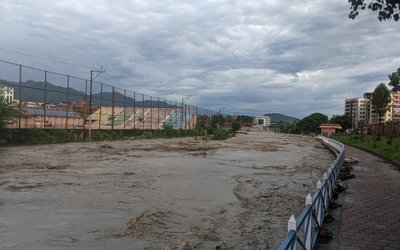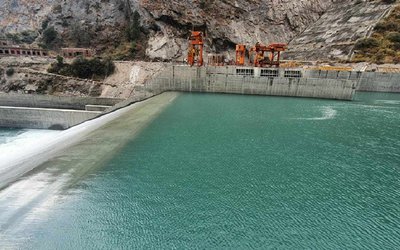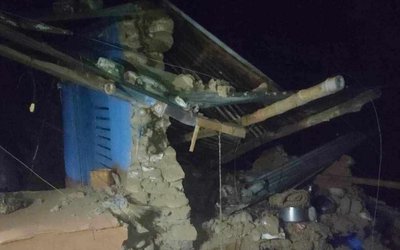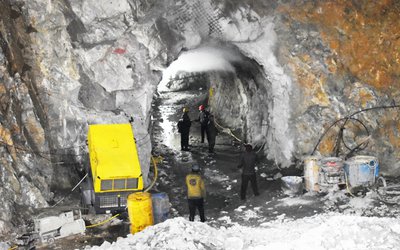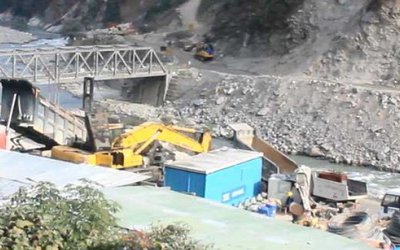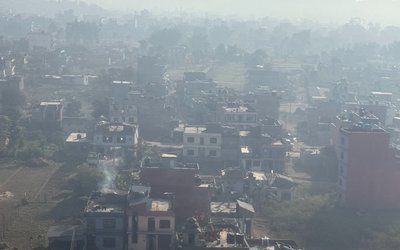
As the gates of head-work starts to shut down to fill the water today, along with all his colleagues, contractors and consultants, the moment was a long visualized day to Chief Executive Officer of Upper Tamakosi Hydropower Project (UTEP) Bigyan Prasad Shrestha.
CEO Shrestha has seen many difficult period including a major earthquake of 2015, landslides, scarcity of diesel, slow work by contractor and so on. Finally, he has seen damming the river to divert huge amount of water to two de-sanding basins.

Completing over 99 percent work and close to completion, the reason of joy among the person involved in the construction of the project is understandable .
Following the earthquake in 2015, there were so many devastation and destruction and no body know where to start the work. The landslides further damage the project. With commitment and dedication of Shrestha along with his colleagues, Nepal's mammoth project with Nepali investment is finally close to the completion.
As the project was still in the uncertain and difficult time, the decisions and back up support given by Managing Director Kul Man Ghising, who has been visiting the project regularly, and then minister of Energy Janardan Sharma and secretary Anup Kumar Upadhyaya were remarkable.
For MD Ghising, competing the project has been his major priority since he took charge of NEA's MD. He had recently visited the project site and instructed the concerned officials to accelerate works while assuring to facilitate in removing any hurdle faced by the contractors.
Similarly, Minister for Energy, Water Resources and Irrigation Barsha Man Pun, along with Dinesh Ghimire, secretary at the ministry, had also visited the site and directed the concerned stakeholders to complete the works within the stipulated deadline.
All the efforts of overcoming the challenges, Upper Tamakosi 456 MW, Nepal's largest hydropower project, has started filling the reservoir from today and it will test head-work and de-sanding basins..
The test of head-work aims to meet the latest completion deadline of July 15. The gross head height of the dam is 822m. Flood and discharge capacities for the facility are 885m³/s and 66m³/s, respectively and the dam has storage capacity is around 1.2 million cubic meters.
Upper Tamakosi comprises a 22m-high and 60m-long concrete dam, two 225m-long de-sanding basins, an 8.4km-long headrace tunnel with 32.14m² of cross-sectional area, and an underground powerhouse (142m-long, 13m-wide, and 25m-high) equipped with six Pelton turbine units.

"As the completion of deadline is nearing, we have initiated the tests of headworks and de-sanding basins," said Bigyan Shrestha, Chief Executive Officer of UTHP.
“Although we have started filling the reservoir today, it will take at least seven days to fully fill it and conduct the final test of head-work and de-sanding,” said Shrestha. "Almost 99.3 per cent of works of the project has been completed so far."
"We have been mobilizing the large numbers of people to accelerate the construction activities," said Shrestha. Following the completion of this test, the company is also planning to test the 49km-long double circuit 220kV transmission line between Gongar and the Khimti power station.

Although it was delayed earlier due to earthquake, political disputes, scarcity of diesel, landslides and delay of work by contractor Texmaco Railway Engineering of India, the process of installation of penstock pipe has accelerated now. Till now Out of 683 meters 395 meters of pen-stock pipes have been installed in the tunnel.
Texmaco Railway Engineering of India, which is responsible to install pen-stock pipes along 373 meters of the vertical tunnel has installed a total of 145 meters of the pipes. Andritz Hydro, an Austria-based contractor, which is responsible to install the pipes along 310 meters of the tunnel, has completed installing 250 meters of the pipes so far.
Although the Texmaco Railway Engineering of India is responsible for the work Andritz Hydro was brought in, in January of last year to take on part of installing the penstock pipes to accelerate the construction. Texmaco, an engineering and infrastructure company based in India, was engaged for the hydro-mechanical works for the project.
The civil works contract for the project was awarded to Sinohydro Corporation. Andritz Hydro was awarded the contract for the design, manufacturing, and supply of electromechanical equipment, including turbines and generators for the project.
KEC International was contracted for the supply and erection of transmission lines as well as the substation. Norconsult and Lahmeyer provided detailed project design, construction management and monitoring services for the project.

Coronavirus outbreak has not affected the project. “Our staffers and contractors are working on a full-fledged manner by utilizing the available resources,” said Shrestha. He said that the works related to civil, electromechanical, transmission lines have almost completed.
As per the revised deadline, the project is scheduled to produce 76 megawatts of power from the first unit of its six units by mid-July.
After the completion, the Upper Tamakosi hydro-power station is expected to produce 2,281 GWh of electricity a year.
- 550,000 Students' Future At Stake Due To Teachers' strike
- Apr 17, 2025
- Weather Forecast: Mainly Fair To Partly Cloudy In Kathmandu, Lumbini, Madhesh and Surkhet
- Apr 17, 2025
- Pakistani Embassy In Kathmandu Hosted A Reception On 85th National Day
- Apr 16, 2025
- Earthquake Rocks Kathmandu Valley
- Apr 16, 2025
- Prof Dr Khadga KC assigned responsibility of TU Vice Chancellor
- Apr 16, 2025
